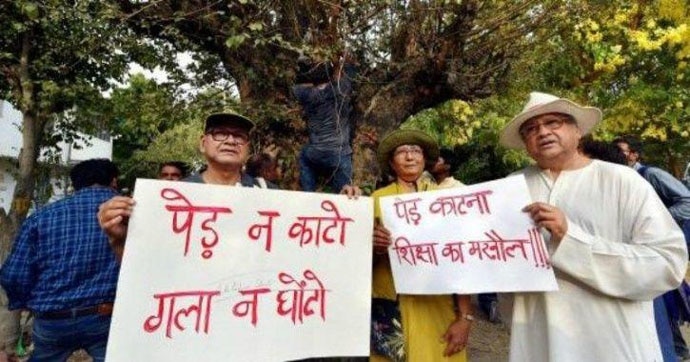What the Centre’s plan to redevelop prime land in central Delhi reveals

This monsoon, it was not just the rain clouds that hung low over the City of Djinns
This monsoon, it was not just the rain clouds that hung low over the 'City of Djinns'. The dark clouds of Delhi’s inherent character being irrevocably changed also stared its citizens in the face. And the citizens rose to the challenge.
What began as a campaign to save the city’s trees from the government’s plan to “redevelop” huge swathes of forested land in Central Delhi moved on to citizens analysing the legal sanctity of such a move by the Centre.

Scrutiny of documents in the public domain opened a Pandora’s Box — permissions for felling of thousands of trees has been granted in a most cavalier manner by the state, land usages were changed by the Delhi Development Authority (DDA), which functions under the Centre, and sacrosanct urban and environmental governance principles were circumvented by two Union ministries — ironically, by those meant to improve cities and protect the environment and forests.
It didn’t take long to conclude that the area was being cleared by the Ministry of Housing & Urban Development (MoHUA) on the basis of permissions obtained from the Ministry of Environment, Forest and Climate Change (MoEFCC), and sanctified by a MoU with the National Building Construction Corporation (NBCC).
What has been uncovered is that the government is trying to get its hands on prime real estate and “redevelop” it at a profligate bill of Rs 32,835 crore — prima facie, a highly wasteful expenditure. The fig leaf, of the Union government conducting the redevelopment to provide housing to government employees, seem to have gone with the wind.
What is the government’s stated position in such matters? When Prime Minister Narendra Modi assumed office, he spoke of “maximum governance, minimum government”, indicating the government’s intent to be a policy maker and facilitator, and divest from business activities best left to the industry. His government ushered in an era of reform and innovation, briskly setting right the corruption and crony capitalism era of the previous political dispensations.
In this scenario, a vexatious question arises — why has the government preferred to remain vested in the construction and redevelopment of 7 General Pool Residential Accommodation (GPRA) colonies, professing a bleeding-heart anguish on the lack of houses for government employees, instead of letting market forces deal with the “acute” housing shortage?
The specious reason proffered by MoHUA is the proximity to of the seven GPRA colonies to Central Secretariat, the workplace for most government employees. This does not hold water.
With the rapid expansion of Metro services to the far-flung stretches of the NCR, the Central Secretariat is accessible to all. Government employees are children of the same gods as the other residents of Delhi, and if ordinary citizens can travel by Metro to work, so can government personnel. Moreover, the houses could have been constructed under the Pradhan Mantri Awas Yojana at a fraction of the cost estimated under the GPRA redevelopment project.

The answer is not difficult to comprehend — the devil lies in the numbers.
A back-of-the-envelope calculation reveals that after the redevelopment, the total number of flats will merely double — from 12,970 dwelling units now to 25,667 dwelling units. Simultaneously, 2,37,9775 sq meters of commercial building and towers are being created besides the World Trade Centre at Narouji Nagar, where housing has been totally wiped out. In the other colonies, a preponderance of the development is focused on commercial space rather than residential space, giving the lie to the government’s claim that the redevelopment is for housing purposes.
Since the role of the government is to govern, by its very definition, it should keep at an arm’s length from the industry. One of the imperatives of good governance is to ensure there is no conflict of interest in all transactions — Caesar’s wife should be above suspicion.
However, the manner in which the central government has kept the redevelopment close to its chest gives rise to suspicion over its motives. This is exacerbated by the huge commercial development component of what was touted as a housing scheme, and the ease with which intra-ministry approvals have been granted.
By engaging itself in construction and redevelopment of prime land in Central Delhi, the government has not clothed itself in glory. Indeed, it has breached inviolable principles of public trust and engaged in “conflict of interest”, both sacrosanct boundaries for good governance.
Pandora’s Box has thus been opened and is in full public gaze.
A disdain for the environment and public health, natural resources, biodiversity, and trees comes through quite clearly. With Delhi vying hard for the 'crown' of the most polluted city in world, the government stands in the dock for egregious depredations to this beautiful city.
Even William Darlymple’s mythical djinns, that are said to assure Delhi’s phoenix-like regeneration no matter how many times it is destroyed, might just give it a pass this time around.
The jury is the citizenry, which will be unforgiving.

